12 Ft Vs 14 Ft Vs 15 Ft Trampoline [The Tussle Of The Three Trampolines]
Trampolines come in various shapes and sizes. And one of the first hiccups to buying a trampoline is knowing which size is right for you.
Is a 12 feet trampoline big enough? Or should you rather spend a bit more and go with a 15 feet trampoline right off the bat?
Well, the answer is not as simple as you might think. I have used many different trampolines in the past. And the thing that I realized is that their size affects their overall performance.
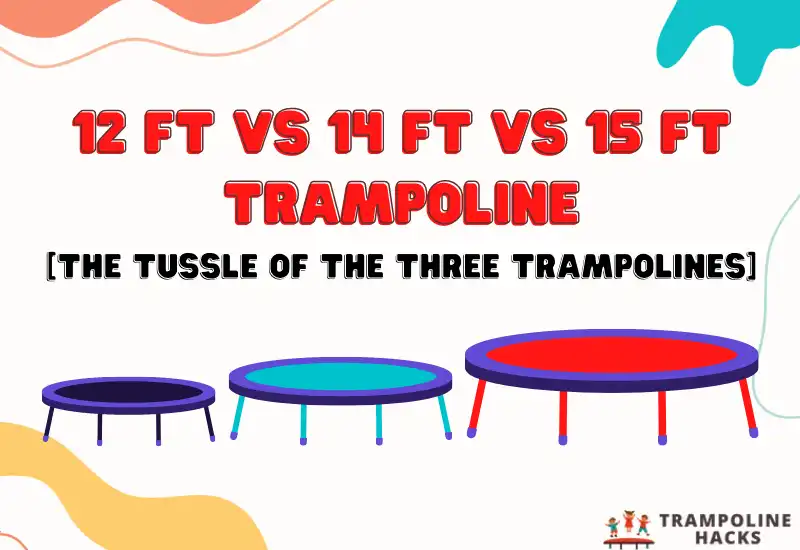
This means, not only will it affect how much area you have to jump around, but also its stability, its bounciness, and even its safety.
The three most common sizes for homeowners are 12 feet, 14 feet, and 15 feet. If you are buying a trampoline for your children, these are the three best sizes for you to choose from. But even when the choice is narrowed down to these three options, you still don’t know which one is the right pick.
Let me change that. I will give you a quick comparison between 12 feet, 14 feet, and 15 feet trampolines so that you are equipped with everything you need to know to pick out the right size for your home.
Key Differences Between a 12 Foot Vs 14 Foot Vs 15 Foot Trampoline
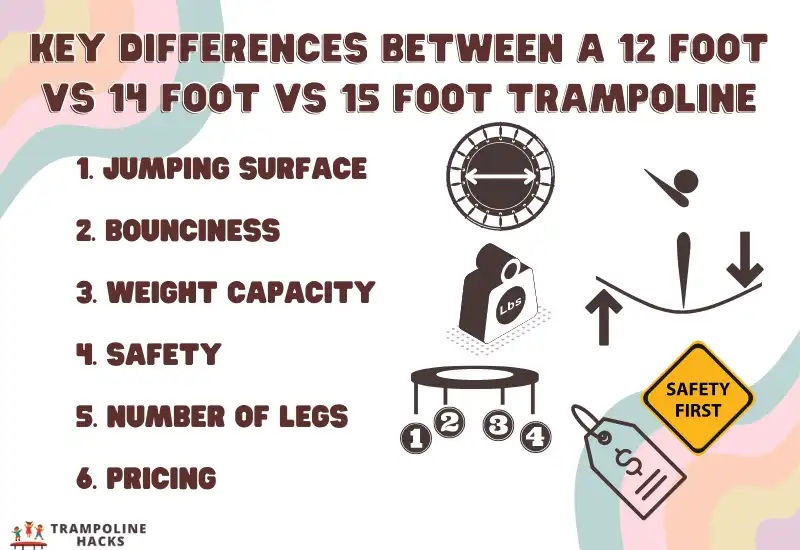
Needless to say, there are some major differences between the three trampoline sizes. So, let me give you a quick rundown of some of the key differences before I help you decide which one you want for your backyard.
1. Jumping Surface
The most apparent difference between the three sizes is the jumping surface. Naturally, a 15 feet trampoline will give you more area to bounce on compared to a 12 feet trampoline.
From all the best rectangle trampolines I’ve seen, almost 70-80% are 15 ft. So, the common shape for 15-feet trampolines is rectangular. And 12 ft trampolines are usually oval or round.
12 feet models are typically designed for kids and can accommodate one or two kids jumping on it at the same time. 14 feet trampolines can support adults, but still, I would recommend limiting it strictly to kids.
However, because of the wider area that you get with a 15 feet trampoline, it is the perfect pick for a couple of kids or two adults jumping on it at the same time. The shape of the trampoline also plays a role in how much jumping surface it gives you.
But 12 feet trampolines typically only come in a round shape. If you are going with a 14 or 15 feet trampoline, you might find it in a rectangular design, which gives you a bit more jumping surface to bounce on.
2. Bounciness
The bounciness of a trampoline depends largely on the number and length of springs supporting it. This is not the only factor, but still, the one that plays the biggest role in dictating its overall bounciness.
Smaller trampolines typically have fewer springs in them, and the size of the spring is also smaller in most cases. By that logic, a 12 feet trampoline is, in most cases, less bouncy compared to 14 feet and 15 feet trampolines.
Most 12 feet trampolines come with around 72 to 84 springs inside them. On the other hand, 14 feet trampolines can feature between 77 to 96 springs, and 15 feet trampolines can come with up to 108 springs. There are, of course, some exceptions here and there.
If you want to know more about the spring number and sizes of different trampoline models, you can check out my article here.
3. Weight Capacity
Another thing that is affected by the number of springs in your trampoline is its weight capacity. A trampoline with more springs can typically support greater weight. With trampolines, bigger is always better – unless you’re buying it for one person only.
While 12 feet trampolines have a weight capacity of 200 to 300 pounds with most models, a 14 feet trampoline can support up to 400 pounds. And when you step up to a 15 feet trampoline, it should be able to support at least up to 500 pounds, which is a huge upgrade.
So, if you plan on buying it for a large family, it is typically best to go with a larger trampoline. But for only one or two kids, a small 12 feet trampoline can offer better value as it takes less space and costs less.
4. Safety
A big reason why many people think twice before buying a trampoline is its safety issues. It is absurd how many accidents happen each year due to trampolines. But in my opinion, a lot of it can be avoided simply by following some basic safety rules when you are jumping on the trampoline.
If you are buying it for kids, sticking with a smaller trampoline might be the better idea as it is easier to manage. Since a 12 feet trampoline has less bounce, it is typically considered safer for kids. But a 14 feet and a 15 feet trampoline can be safe too if you keep an eye on your children when they are jumping on it.
The trick to making a trampoline safe is to place it in a nice spot with plenty of free space around it. I also like to put some cushioning under my trampoline to add an extra layer of safety for the kids.
5. Number of Legs
More legs mean more assembly and more support for the trampoline. Naturally, a bigger trampoline would require more legs to support it. And when a trampoline has more legs, it typically has a greater capacity to support more than one person jumping on it at the same time.
While both 12 and 14 feet trampolines come with three U-shaped legs, most 15 feet trampolines will feature four legs. This design upgrade makes a 15 feet trampoline more stable and lets it carry more weight without worrying about toppling over.
Then again, with more legs, the trampoline will also need more real estate in the garden. So, if you have a tight backyard, a 15 feet trampoline will not be the best choice. For my backyard, I go with a 14 feet model as it gives me decent bounce, support and also does not take up the entirety of my yard.
6. Pricing
Buying a trampoline is by no means a small investment. Even a small 12 feet trampoline can set you back a couple of hundred dollars. If you are buying a new trampoline for your family, then it is quite natural to wonder which size costs more and which size offers the best value.
- A 12 feet trampoline costs a lot less than a 14 or 15 feet model. Typically, you can find a decent 12 feet trampoline for under 300 dollars. When you are going with a 14 feet trampoline, you need to spend around 400 to 500 dollars for a decent model.
- 15 feet trampolines cost even more and often come with a price tag of over 500 dollars. Again, the price range can vary depending on the brand and the model of the trampoline that you want to buy.
Reviews of a 12 ft, 14 ft and 15 ft Trampoline
Knowing which trampoline size you need is only half the battle. If you want to end up with a good trampoline, you need to know your options. Now, I was lucky enough to own and try out a lot of different trampolines in the past. But it might not be possible for everyone.
To save you confusion, let me leave you with a quick review of a couple of my favorite trampolines that I have used over the past.
Favorite 15 feet Trampoline: Zupapa No-Gap Design 15 FT Trampoline for Kids with Safety Enclosure Net
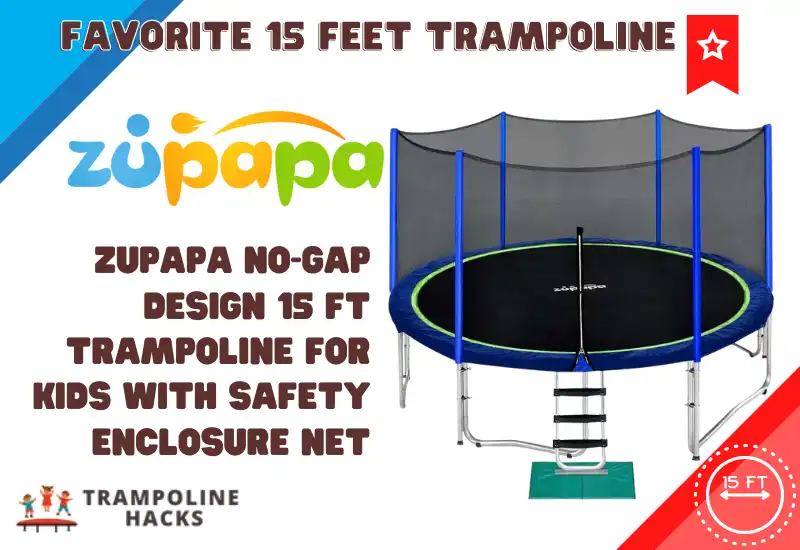
I know I am starting off with an expensive trampoline, but frankly, if you want a 15 feet model, then you should be prepared to spend some greens. 15 feet trampolines are designed for enthusiasts or people with large families and naturally cost a fair bit.
With Zupapa, though, you are getting all your money’s worth. It is one of my all-time favorites. Unfortunately, I had to store it away when I finally moved house a few weeks back as my new backyard does not have enough space for it. Hopefully, in the future, I will get a chance to bring it out again.
This trampoline is built like a tank featuring galvanized rust-resistant springs along with a high-quality alloy steel frame. It comes with four u-shaped legs that ensure proper stability and balance when you have kids bouncing around inside it.
Furthermore, the trampoline features 108 springs opposed to the standard 96 springs that you may find in other 15 feet models. And combined with the 7-inch spring length, this trampoline will give you a bouncing experience like no other.
But that does not mean that it is not safe for children. Thanks to its 6 feet high safety enclosure along with an anti-UV PP jumping mat, you do not have to worry about the safety of your children. And since it can handle up to 425 pounds of body weight, you can even consider jumping in along with your children for some family fun.
The best thing about the trampoline is that its frame features a unique self-locking design that does not use any screws. So, the trampoline is more stable compared to other models where there is a risk of the screw coming loose. As a bonus, you also get a couple of wind stakes to anchor the trampoline to the ground.
If you have the budget and the space to accommodate it, the Zupapa 15 feet trampoline is the obvious choice. It meets and exceeds the safety standards of ASTM and TUV, making it a great pickup if you are worried about the safety of your kids when jumping on the trampoline.
Favorite 14 Feet Trampoline: CalmMax 14 FT Trampoline with Enclosure Net
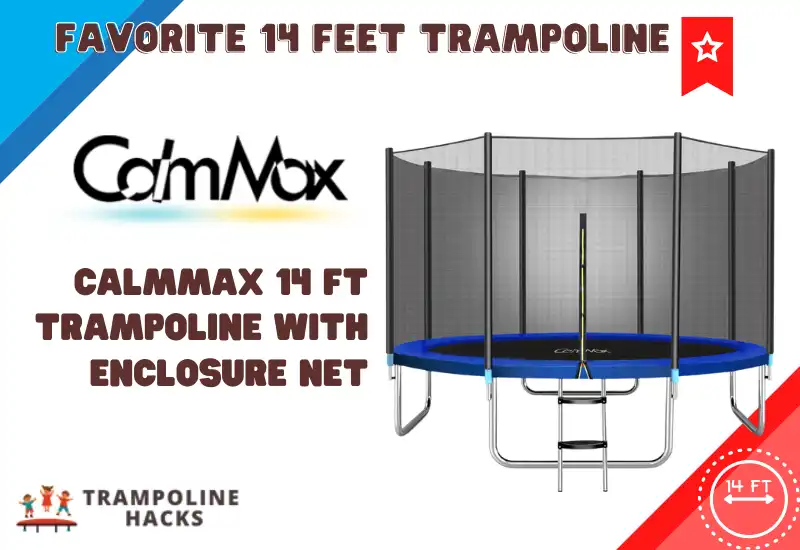
Even though the Zupapa has a 14 feet trampoline, the reason why I prefer the CalmMax here is simple; it is cheaper. In fact, if you were to go with the Zupapa trampoline, I would recommend adding 10 or 20 bucks and getting the 15 feet one. Getting the 14 feet model that costs only a couple of bucks less honestly makes no sense.
But enough about Zupapa, let’s talk about CalmMax. If you are going with a 14 feet trampoline, this one is a great pickup. It has excellent weight capacity, gives you great bounce for your buck, and is also made extremely well. I think this is a well-rounded trampoline at a reasonable price.
The Polypropylene bounce surface of the trampoline complies with EU standards and delivers unprecedented bounce within safety parameters. Tested for over 20000 jumps, you do not have to worry about the mat ripping from rebounding force anytime soon.
The steel frame of the trampoline features three layers of rust proofing to ensure it stays strong even when it is left out in the sun for years. Each of the steel components comes with a zinc coating and is galvanized inside for enhanced durability and performance.
This trampoline can handle up to 400 pounds of weight and comes with four U-shaped legs along with eight contact points for better balance and stability. You also get a sturdy, dual zipper safety net with a latch system that keeps the kids inside a bubble of safety when they are bouncing on the trampoline.
Similar to Zupapa, this trampoline comes in several sizes. But I have only tried the 14 feet model, and that is what I vouch for. However, based on my experience with the trampoline, I can safely assume that the rest of the size options will also give you a solid experience.
Favorite 12 Feet Trampoline: Skywalker Trampolines 12-Foot Jump N’ Dunk Trampoline with Enclosure Net
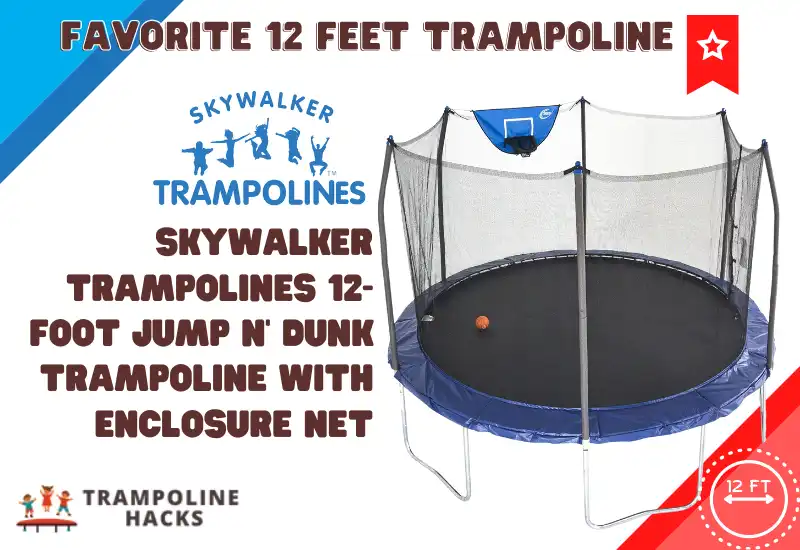
Just a few weeks back, I got a new 12 feet trampoline for my kids. My new home had a small backyard, and I couldn’t get a 14 or 15 feet trampoline to fit in it. So, I decided to go with the Skywalker 12-Foot Jump N’ Dunk. And ever since, they have been bouncing around the trampoline daily in the afternoon.
Trust me when I say this – your kids will love you if you get this one. It includes a free basketball hoop that you can set up on top of the safety enclosure. So, your kids will have something to do inside the trampoline other than bouncing around aimlessly (not that there’s anything wrong with that either).
Remember when I said most 12 feet trampolines come with three legs? Well, this is one of the few models out there that gives you four feet which directly translates to better support and weight capacity.
The jumping pad is also designed well and feels soft and elastic. So, your kids will not complain at all jumping up and down the trampoline. But what I love more is the UV-resistant, Vinyl-coated spring pad that ensures my kids remain safe when they climb on or off the trampoline.
In fact, the safety design of this trampoline is in a league of its own. It comes with strong, galvanized springs along with a patented no-gap enclosure system that practically eliminates all pinch points between the net and the springs. So even if I can’t monitor my kids, I can rest easy knowing that they are safe inside it.
It comes with a total of 72 springs which offers a good blend of safety and bounciness. This trampoline comes in different colors, and I decided to go with the blue one. It looks pretty and blends well with the overall aesthetics of my backyard.
The trampoline can hold up to 200 pounds making it great for one or two kids jumping inside it. But for an adult, it might not be the best choice. If you want even more weight capacity, you can consider going with the Merax 12FT Trampoline with Safety Enclosure Net, which can handle up to 330 pounds.
However, the Merax trampoline costs about 60 to 70 bucks more than the Skywalker trampoline. And the difference in performance, if only kids are using it, is really not that noticeable. For 12 feet trampolines, though, both of these options can be good.
Which Size Trampoline is Ideal for You?
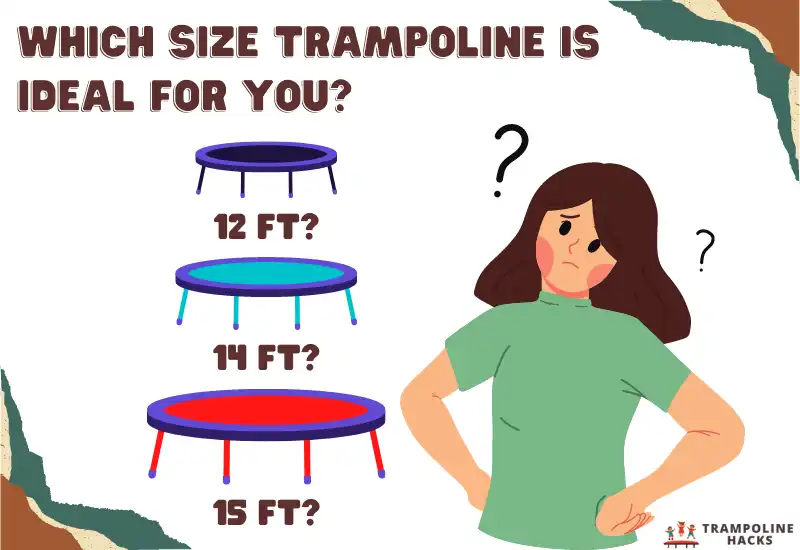
To be completely honest with you, the choice of a trampoline depends on three main factors,
- How much space you have?
- How many people are jumping on it at once?
- And your budget.
For those with two or more kids, a 15 feet trampoline is the obvious choice. But it takes up a bit more yard space compared to the other two sizes. And it’s a bit expensive.
If you have only two kids and a moderately-sized backyard, a 14 feet trampoline can be good too. You might even be able to get a few jumps in yourself when the kids are not using it. The price point is reasonable.
For one kid or an adult, a 12 feet trampoline works well. Since it takes up space, you can put it in any backyard. These are the cheapest of the three different sizes.
So, when you know what you want, it’s a fairly straightforward decision from there. Cheers!
Hi, It’s Jason and Louise here and welcome to our website. We are parents to Hannah and Zachary who absolutely love the outdoors and are actually addicted to jumping on their trampoline. Our amazing little family lives on a beautiful 20-hectare rural property with Horses, Dogs, Cats, Chooks, a Rooster, Cats and also a Pet Kangaroo.